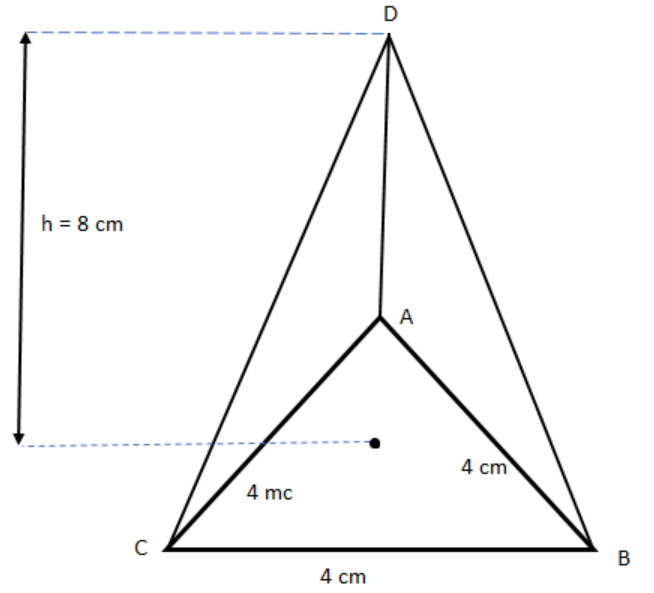
Find the lateral surface area and total surface area of an equilateral triangle-based prism with height 8 cm and base 4 cm.
Answer
579.9k+ views
Hint: First of all, draw the diagram of the equilateral triangle-based prism to have a clear idea of what we have to find. Then use the formula for finding L.S.A and T.S.A of the equilateral triangle-based prism.
Complete step-by-step solution:
Given that the base of the prism is an equilateral triangle with side 4 cm as shown in the given figure:

Let \[p\] be the perimeter of the base of the prism i.e., the perimeter of equilateral \[\Delta ABC\].
So, \[p = 4 + 4 + 4 = 12{\text{ cm}}\]
Given height of the prism \[h = 8\;{\text{cm}}\]
We know that the lateral surface area of the triangle-based prism is given by \[p \times h\] where \[p\] is the perimeter of the base triangle and \[h\] is the height of the prism.
Therefore, L.S.A of the prism \[ = p \times h = 12 \times 8 = 96{\text{ c}}{{\text{m}}^2}\]
Now, consider the area of equilateral \[\Delta ABC\].
We know that the area of the equilateral triangle with side \[a\] is given by \[\dfrac{{{a^2}}}{4}\].
So, area of \[\Delta ABC = \dfrac{{\sqrt 3 {{\left( 4 \right)}^2}}}{4} = 4\sqrt 3 \]
We know that the total surface area of the triangle based prism with base area \[A\], perimeter \[p\] and \[h\] is the height of the prism is given by \[2 \times A + p \times h\].
Therefore, the total surface area of the prism \[ = 2 \times 4\sqrt 3 + 12 \times 8\]
\[
= 8\sqrt 3 + 96 \\
= 8\left( {1.73} \right) + 96 \\
= 13.84 + 96 \\
= 109.84{\text{ c}}{{\text{m}}^2} \]
Thus, the L.S.A of the prism is \[96{\text{ c}}{{\text{m}}^2}\] and the T.S.A of the prism is \[{\text{109}}{\text{.84 c}}{{\text{m}}^2}\].
Note: The lateral surface area of the triangle-based prism is given by \[p \times h\] where \[p\] is the perimeter of the base triangle and \[h\] is the height of the prism. The total surface area of the triangle based prism with base area \[A\], perimeter \[p\] and \[h\] is the height of the prism is given by \[2 \times A + p \times h\].
Complete step-by-step solution:
Given that the base of the prism is an equilateral triangle with side 4 cm as shown in the given figure:

Let \[p\] be the perimeter of the base of the prism i.e., the perimeter of equilateral \[\Delta ABC\].
So, \[p = 4 + 4 + 4 = 12{\text{ cm}}\]
Given height of the prism \[h = 8\;{\text{cm}}\]
We know that the lateral surface area of the triangle-based prism is given by \[p \times h\] where \[p\] is the perimeter of the base triangle and \[h\] is the height of the prism.
Therefore, L.S.A of the prism \[ = p \times h = 12 \times 8 = 96{\text{ c}}{{\text{m}}^2}\]
Now, consider the area of equilateral \[\Delta ABC\].
We know that the area of the equilateral triangle with side \[a\] is given by \[\dfrac{{{a^2}}}{4}\].
So, area of \[\Delta ABC = \dfrac{{\sqrt 3 {{\left( 4 \right)}^2}}}{4} = 4\sqrt 3 \]
We know that the total surface area of the triangle based prism with base area \[A\], perimeter \[p\] and \[h\] is the height of the prism is given by \[2 \times A + p \times h\].
Therefore, the total surface area of the prism \[ = 2 \times 4\sqrt 3 + 12 \times 8\]
\[
= 8\sqrt 3 + 96 \\
= 8\left( {1.73} \right) + 96 \\
= 13.84 + 96 \\
= 109.84{\text{ c}}{{\text{m}}^2} \]
Thus, the L.S.A of the prism is \[96{\text{ c}}{{\text{m}}^2}\] and the T.S.A of the prism is \[{\text{109}}{\text{.84 c}}{{\text{m}}^2}\].
Note: The lateral surface area of the triangle-based prism is given by \[p \times h\] where \[p\] is the perimeter of the base triangle and \[h\] is the height of the prism. The total surface area of the triangle based prism with base area \[A\], perimeter \[p\] and \[h\] is the height of the prism is given by \[2 \times A + p \times h\].
Recently Updated Pages
Master Class 10 General Knowledge: Engaging Questions & Answers for Success

Master Class 10 Computer Science: Engaging Questions & Answers for Success

Master Class 10 English: Engaging Questions & Answers for Success

Master Class 10 Social Science: Engaging Questions & Answers for Success

Master Class 10 Maths: Engaging Questions & Answers for Success

Master Class 10 Science: Engaging Questions & Answers for Success

Trending doubts
The shortest day of the year in India

Why is there a time difference of about 5 hours between class 10 social science CBSE

Write a letter to the principal requesting him to grant class 10 english CBSE

What is the median of the first 10 natural numbers class 10 maths CBSE

The Equation xxx + 2 is Satisfied when x is Equal to Class 10 Maths

Which of the following does not have a fundamental class 10 physics CBSE




